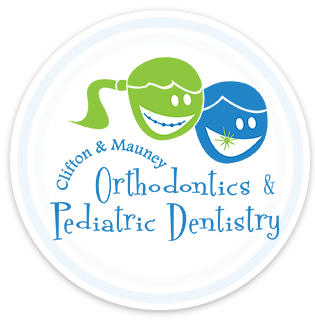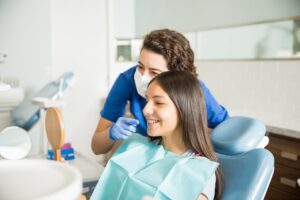Many parents wonder about the right time to take their child to the orthodontist. Early orthodontic evaluations can make a significant difference in a child’s dental development; an early visit helps determine if your child may benefit from phase one orthodontics, also known as interceptive orthodontic treatment.
Clifton & Mauney offers early orthodontic treatment services in Chapel Hill, NC. We can evaluate your child’s orthodontic needs and create a care plan that keeps their smile happy and healthy for years to come.
How Early Can My Child See an Orthodontist?
Children can see an orthodontist as early as age seven, according to guidelines from the American Association of Orthodontists. At this age, an orthodontist can identify potential issues with jaw growth, tooth alignment, or bite problems and determine if phase one orthodontics is beneficial. Phase one orthodontic treatment focuses on guiding proper jaw development and addressing issues early to prevent more complex problems later. Starting early ensures your child’s teeth and smile are set up for long-term health and success.
What Is Phase One Orthodontics?
Phase one orthodontics is an early intervention treatment designed to address dental and jaw growth issues before all permanent teeth have erupted. This phase typically occurs between the ages of six and ten, during a time when a child still has a mix of baby and permanent teeth. The primary goal is to guide the proper development of the jaw and teeth, creating enough space for permanent teeth to come in correctly and reducing the need for extensive treatments later on. Common issues addressed in phase one include crowding, bite misalignment, crossbites, overbites, underbites, and jaw discrepancies.
By tackling these problems early, phase one treatment can help prevent more severe dental and orthodontic issues in the future, improving not just oral health but also a child’s confidence and overall well-being. It often involves braces, expanders, or other appliances tailored to the child’s unique needs, and the results can positively influence the development of a healthy, functional smile.
Are Phase One Orthodontics Necessary?
Not every child needs phase one orthodontic treatment, but in cases where early intervention can prevent more extensive treatment later, it can be highly beneficial. An orthodontist will assess factors such as severe crowding, crossbites, open bites, and protruding teeth to determine if phase one treatment is necessary. If left untreated, these issues can lead to difficulties with chewing, speech development, and even increased risk of tooth damage.
Phase One vs. Phase Two Orthodontics
Understanding the difference between phase one and phase two orthodontics is essential for parents.
- Phase one orthodontics – Occurs while a child still has some baby teeth and focuses on guiding jaw growth, creating space for permanent teeth, and addressing functional issues early.
- Phase two orthodontics – Happens once all permanent teeth have erupted, typically in the early teenage years. This phase focuses on final alignment and bite correction using braces or clear aligners.
If a child undergoes phase one treatment, they may still need phase two orthodontics later, but the first phase often simplifies and shortens the duration of the second phase.
How Long Is Phase One Orthodontics?
The length of phase one orthodontic treatment varies depending on the child’s needs, but it generally lasts between 12 and 18 months. After completing this phase, children may enter a resting period where the orthodontist monitors their dental development before considering phase two treatment if needed.
What to Expect in Interceptive Orthodontic Treatment
During phase one orthodontic treatment, children may receive various appliances tailored to their specific dental needs, such as expanders to widen the jaw, partial braces to align teeth, or space maintainers to hold room for incoming permanent teeth. These appliances are designed to address early dental issues and guide proper growth and development. Regular checkups will be required to monitor progress, ensure the appliances are functioning correctly, and make any necessary adjustments to the treatment plan.
Parents should expect their child to visit the orthodontist every 6-8 weeks for these checkups, which may include minor modifications to the appliances, ensuring the treatment stays on track and delivers the best results. Establishing a consistent care routine at home, such as proper cleaning and following the orthodontist’s instructions, will help maximize the benefits of phase one treatment.
Choose Clifton & Mauney for Early Orthodontic Intervention
Early orthodontic intervention can play a crucial role in ensuring your child’s long-term dental health. If you’re unsure whether your child needs phase one orthodontics, scheduling an evaluation with Clifton & Mauney can provide clarity and guidance. By addressing orthodontic concerns early, you can help your child achieve a healthy and confident smile for years to come. Contact us at 919.933.1007 or online to schedule a consultation today.




